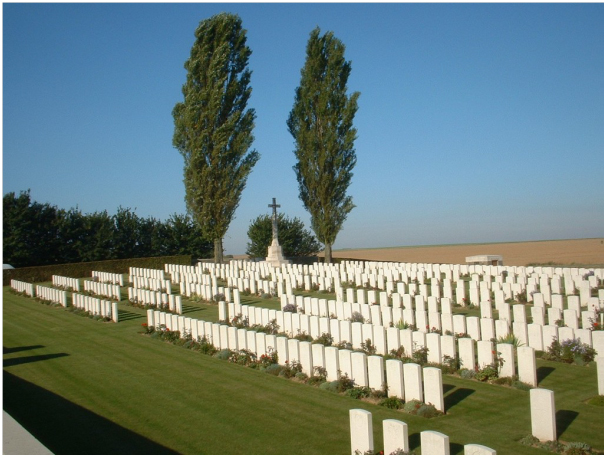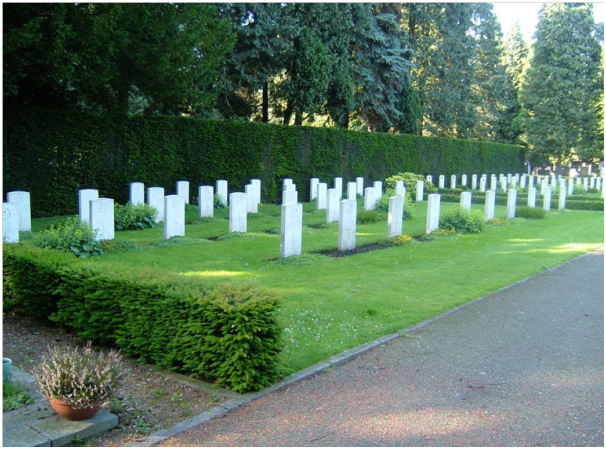LOCAL IDENTITIES
Military
1153, Cpl Lawrence Carthage Weathers, 43 Battalion, Australian Infantry
was the: “son of John Joseph and Ellen Frances Johanna Weathers.
Husband of Annie E Weathers, and resided at ‘Te Kopuru’, Main Avenue, Frewville, South Australia. A native of North Wairo, New Zealand.”
So reads the inscription on his casualty certificate from the Commonwealth War Graves Commission website
 Unicorn Cemetery, Vendhuile France
Unicorn Cemetery, Vendhuile France
Lawrence was born in Te Kopuru on May 14th 1890 his parents were both from Australia. He had a sister Florence born in 1887 also in Te Kopuru. He later moved to South Australia where he lived with his wife Annie and as he obviously had a great fondness for his place of birth named his house ‘Te Kopuru’.
Lawrence joined the Australian army during the first World War and served with the 43rd Battalion Australian Infantry, he was with the battalion when it crossed the River Somme on the 30th of August 1918.
On September the 2nd they met strong enemy resistance near Cambria and St Quentin, he was critically wounded and died of his injuries on the 29th of that month, unaware that he had awarded the Victoria Cross.
An extract from the London Gazette. No 31082 dated 24th December 1918 records the following:
“For most conspicuous bravery and devotion to duty on the 2nd September, 1918, north of Peronne, when with an advanced bombing party. The attack having been held up by a strongly held enemy trench, Cpl. Weathers went forward alone under heavy fire and attacked the enemy with bombs. Then, returning to our lines for a further supply of bombs, he again went forward with three comrades, and attacked under very heavy fire. Regardless of personal danger, he mounted the enemy parapet and bombed the trench, and, with the support of his comrades, captured 180 prisoners and three machine guns. His valour and determination resulted in the successful capture of the final objective, and saved the lives of many of his comrades.”
40781 Flying Officer Pilot Thomas George Bassett. Royal Air Force.
‘who died on 12 May 1940 Age 22.Son of John Leonard and Lena Bassett, of Te Kopuru, Auckland, New Zealand’
is recorded on the Certificate of Commemoration at the Commonwealth War Grave Commissions website.

Maastritch General Cemetery
Thomas was with 15 Squadron based at RAF Station Alconbury flying Bristol Blenheims.
On the 12th of May 1940, 24 Blenhiems took of and an attempt was made to check the German advance towards Brussels by bombing road junctions and bridges over the Albert canal near Maastricht.
Of the 12 aircraft of 15 Squadron that took of from Alconbury half of them were lost, they faced not only heavy anti-aircraft fire in the target area but were also attacked by enemy fighters, three of the aircraft lost were captained by New Zelanders,
Flying Officer Bassett, piloting Blenhiem L8847 crashed at Borghaven (Limburg), near Maastricht, The Netherlands on the 12th of May. His crew, Sergeant N C Middlemass and Leading Aircraftman W T Cavanagh also perished, they are remembered at Maastritch General Cemetery
Two weeks later on the 26th of May the evacuation of the British Troops from the beaches of Dunkirk began
811123 Private Len Helmbright DCM
DCM Citation
Private Helmbright showed outstanding courage and resourcefulness during an attack on 24 July 1944 in the advance to the PESA RIVER, Italy. When his section Commander was wounded, PTE Helmbright took command of the section and attacked three machine gun posts. With a light machine gun he went forward under heavy machine gun fire directed at him and wiped out single-handed two of the enemy posts. It was this great deed that enabled the platoon to move forward. Through this and subsequent actions he showed devotion to duty, courage and determination of the very highest order
===========================
Leonard Helmbright was born to Reginald Helmbright and Parekohai Waiariki on January 27th 1920. He was to become an outstanding warrior of Tumatauenga. From an early age Len worked hard on the land. He joined the Maori Battalion during the Italian Campaign and presented many challenges for his officers but was skilful in softening enemy defences with his solitary infiltrating tactics.
Len was an unforgettable character - larger than life, gregarious, hardworking, loyal with a great sense of humor. He never forgot his comrades and they would never forget him. Len spent many years farming around Dargaville. In his later years he purchased the hotel at Aratapu and was well known for both his hospitality and the way in which he settled disputes. "Lets go and sort things out..........'
Len was a well respected member of the Northern Wairoa RSA and the local community, he was also very popular with the pupils at The Te Kopuru Primary school when he attended their annual ANZAC commemoration parades along with other local RSA men and women.
His medals were always a point of interest to them as was his re-enactment of his time in the Italian campaign .
He died on the 15th of November 2001 and is buried in the Te Kaha Cemetery.
---------------------------
I wish to thank the archivist of the 28th Maori Battalion for permission to source some of the above for information on the Battalion refer here… http://www.28maoribattalion.org.nz/
Doctor Eleanor Baker Mclaglan
Eleanor Baker was initially a bit of a mystery, both of the very informative books on the Northern Wairoa, Stallworthys’ “Early Northern Wairoa” and Bradleys’ “The Great Northern Wairoa” made no mention of her, neither did Ivy Pratts’ 1992 “History of Te Kopuru Hospital” which was published for the 90th anniversary of the hospital in 1992. On reading her Autobiography it became quite obvious that whilst she was a very dedicated doctor male chauvinism made her work very difficult.
Eleanor Baker was born at French Farm Akaroa in 1879, she was the eldest of four daughters of Thomas Baker an Oxford educated stock farmer and Josephine Dicken. Her father ran his own boys at French Farm and later at Goodwood Otago after a brief two year spell in Hobart.
Eleanor shared her education at her father’s boys school spending the last two years at Otago Girls High School from which she matriculated.
Her parents decided she should be a doctor for which she initially had little enthusiasm so in 1897 she set of to the Otago Medical School, at this time only two women had qualified so Eleanor joined the other five who were currently studying. In 1902 she passed her final exams and became the sixth female in New Zealand to qualify. In order to get her full qualifications to practice midwifery she went to Coombe Lying-In Hospital in Dublin, returning to New Zealand in 1904.
From then, until 1914, she took a variety of temporary appointments including the hospital at Te Kopuru as well as some locum positions with other doctors in various parts of the country. Lack of finance and prejudice against female doctors thwarted her attempt to set up in private practice, Eleanor finally wound up back in Te Kopuru in private practice.
The three years Baker spent in Te Kopuru, although physically and financially hard, were in many ways the highlight of her medical career. Her inexhaustible energy sustained her through perilous operations, night-time call-outs, long journeys on horseback, and the many other demands of a country practice. Her advice was even sought on the treatment of sick animals. During the 1913 smallpox epidemic she acted as agent for the Department of Public Health, vaccinating Maori in settlements around Dargaville.
By this time Baker had decided that she needed further training and experience, and she gained a position as house surgeon at Auckland Hospital. Struggling against the 'organised ill-will' of male colleagues, Baker was eventually engineered into tendering her resignation. After a period of 'black, black despair', she accepted a position in the school medical service, even though she sadly thought it was the end of 'real' medicine for her. But if bureaucracy seemed tedious, state employment at least provided security and a steady if unspectacular income. She was appointed to the Canterbury–Westland area by the Department of Education in February 1914.
Although she desperately missed her Northland patients, her horses and the outdoor life she had enjoyed, Baker none the less discovered that school medicine had its rewards, and that diagnosis of even mild physical problems could transform a child's life. She initiated special classes for children with defective speech, in the 1920s published in the New Zealand Medical Journal (with Dr Charles Hercus) path-breaking research into the incidence of goitre in New Zealand, and in the 1930s became heavily involved in the children's health camps movement. In 1923 she hosted the first annual meeting of the New Zealand Medical Women's Association, becoming one of its first three vice presidents.
While little is known of Baker's private life during this time, she travelled to Britain in August 1923, and on 29 December that year in London married Sydney Leopold Temple McLaglan, a widower, seven years her junior and a captain in the Middlesex Regiment. The couple returned to New Zealand and lived together until at least 1926, but the marriage was apparently short-lived. In 1928 he was residing in Sydney and in 1932 he brought a lawsuit against his brother Victor, he was last ‘sighted’ in 1942.
There is no mention of it in Eleanor's autobiography, nor in obituaries; her death certificate describes her as a widow. There were no children of the marriage.
Eleanor Baker McLaglan, as she continued to style herself, retired from school medicine in 1940, but the Second World War opened up new opportunities for her. At 60 she became a house surgeon, first in Melbourne, then in Timaru and Wanganui, and was later a junior registrar in Wellington. The respect and liking with which she was treated by younger male doctors finally exorcised the unpleasant experiences of her early career. Eleanor Baker McLaglan ended her working life as second in command of the geriatric hospital at Silverstream, near Wellington. She retired at the age of 73.
During her retirement she lived in Auckland and wrote her autobiography, Stethoscope and Saddlebags, which was published in 1965. She died at Selwyn Village, Auckland, on 20 September 1969.
Sir Thomas Clifton Webb KCMG
Work In Progress
